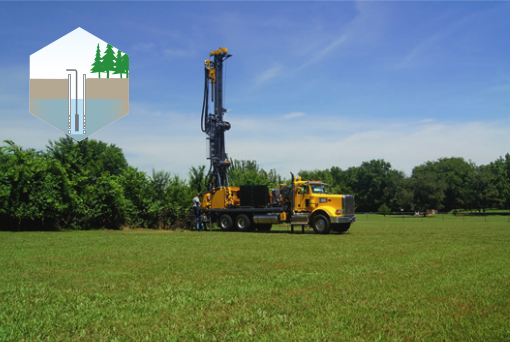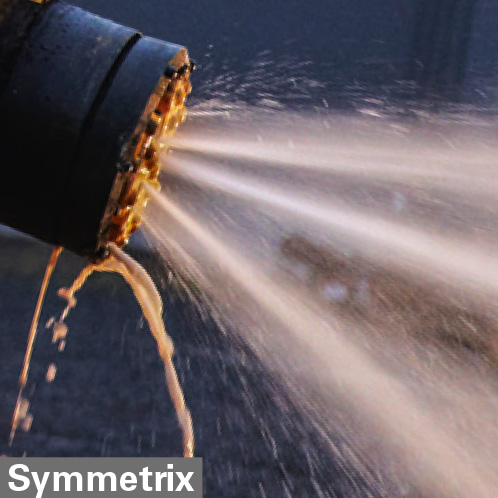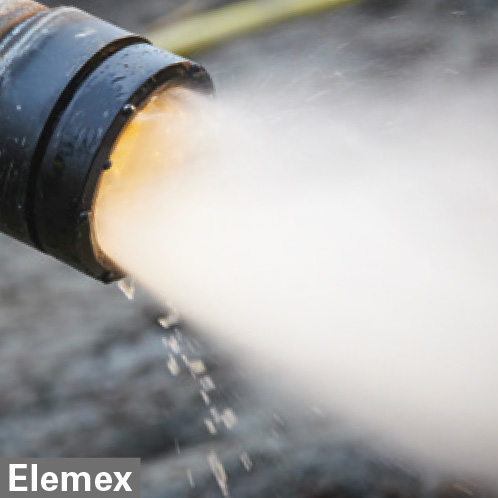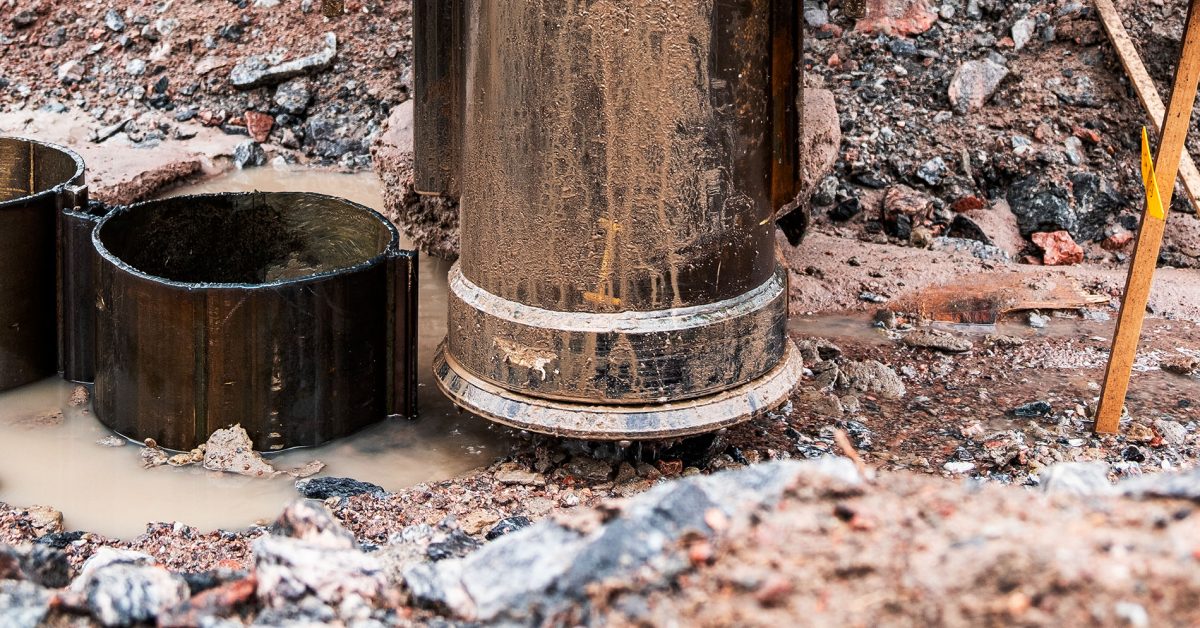Engineers are continually challenged with the risk of hole collapse when faced with drilling through overburden and unconsolidated formations. That is why it is prudent to use drilling casings to drill through overburden while advancing the drilling casing and protecting the hole at the same time.
The aim of this blog is to tell you everything you need to know about this ingenious product so you can make an informed decision as to whether it is the right solution for your drilling program.
After reading our guide, you will have an understanding of what casing advancement systems are, when and where to use them and which casing advancement systems are suitable for your project.
What is a drilling casing?
A drilling casing is a type of drilling tool that enables you to case and drill simultaneously. It can be used with rotary percussion drilling where the impact of the hammer drives the casing down the wellbore.
Installing casing, while drilling, minimizes the risk of holes collapsing and enables projects to be completed faster and more efficiently. For this reason, casing advancement systems add value whether installing foundations, support elements, or casing a hole in formations where hole collapse is possible.
Casing advancement systems, or drilled casings, are used when ground conditions make it difficult to drill, such as in loose formations or drilling through highly fractured rock.
Where to use drilled casings?
Ninety percent of the earth’s ground conditions are loose, unconsolidated, and rocky. Drilling in these formations is often challenging and the risk of collapsing, hole deviation, and failure to reach the intended depth is a real concern for drilling contractors.
Installing drilling casing as the hole is drilled helps to stabilize loose, or unpredictable formations, and shore up the hole. This is particularly the case when penetrating clay, silt, sand, gravel, cobbles, boulders, and fractured rock.
Casing and drilling simultaneously improve drilling efficiency. If you need to speed up drilling time, adding a casing advancement system to your drilling toolbox will go a long way to improving productivity and the drill time on your project.
How to select the right Casing Advancement System
Selecting the right system will depend on the drilling application or purpose. There are several factors to consider: the ground formation and type, the drilling method, whether a permanent or retrievable casing is required, the outside diameter of the casing, the wall thickness, the ring bit ID, as well as the casing and rock socket depth. Armed with this knowledge, we can then specify the appropriate system.
Below are examples of the most common applications:
Geothermal well drilling
The use of geothermal heating in houses has become increasingly popular as it provides both economical and environmental advantages for the user.
Casing advancement systems are useful when drilling a geothermal well as they keep the hole open during installation of the heat exchange system and minimizes any impact on the surrounding structures. It also prevents the collapse of the well during drilling where ground conditions are unstable.
Water well drilling
Water well drilling is commonly done in urban areas where drilling at speed is necessary to minimize disruptions to residents, as well as in the developed area where drilling is taking place.

In these instances, casing advancement systems are used to case the hole as it is drilled, providing stability for the hole, and preventing any collapse which could cause contamination of the water supply or damage to nearby city structures. This helps contractors to complete projects more quickly in urban areas, keeping disruption to a minimum.
Pipe Roofing
Tunneling can be both challenging and dangerous, and as more projects are undertaken in already developed areas where ground conditions are overburdened or weak, the issue of safety becomes even more pressing.
Tackling these challenges requires innovative methods of ground support, like pipe roofing, which reinforces the ground prior to the tunnel facing being installed. The steel casings are inserted during drilling in an umbrella pattern to form a protected arch above the advancing tunnel.
Casing advancement systems are used in this instance as pre-support structures during tunnel construction, making it safer for contractors to drill.
Foundation work
Reliable foundation drilling is essential to the success of any construction project. Drill rigs are used to bore huge holes deep into the earth’s surface to insert piles that are the base upon which a structure is erected.

Installed casings act as load-bearing support, while in friction piles the casing is only used as an element to keep the hole open during the drilling process.
Casing advancement systems offer contractors a fast and easy way to construct load-bearing walls in challenging ground conditions. They also offer huge savings in construction time and materials, by simplifying the construction process.
Anchoring
Tieback anchors are horizontal wires or rods that are used to strengthen and stabilize retaining walls during the construction process. They provide support for slopes and are anchored to the wall, connecting to a stable structure to provide individual or systematic support.
In most cases, casing advancement systems are used to keep the hole open during the anchor installation. This method is used when ground conditions are unstable to allow the installation of the tieback after drilling has been completed.
Tailoring drilling casing to your project
Every drilling project comes with its own set of unique challenges, whether it is drilling in difficult ground, ensuring the safety of workers, minimizing surrounding structural damage, or improving productivity to fast-track projects and minimize disruption in built environments.
Fortunately, casing advancement systems offer a spectrum of solutions to meet your project demands in the most efficient way possible.
TerraRoc offers two types of system, both using the rotary percussion drilling method. The first is an eccentric system represented by ODEX, preferred for shallow holes, easier ground conditions, and where hole straightness is not that important. Casings come in up to 273 mm (10 ¾”) diameter.
The second is a concentric system. There are two products in the range: Symmetrix and Elemex, the latter with its controlled air flush. Symmetrix drills straight holes with little deviation and is suitable for various ground applications and drilling angles. It is used to drill deeper holes, tackle big boulders, difficult ground, and projects where a rock socket is needed. Casings are available up to 1219 mm (48”) diameter and come in different sizes and models, with a wide range of wall casings.


The Elemex casing advancement system is the preferred option when drilling in sensitive ground because air is redirected against the inner wall of the ring bit rather than the face. This controls the spread and intensity of flushing and prevents air escape and damage to the surrounding area. The result is improved flushing and, in some cases, higher drilling rates. Elemex is available in different models and sizes and in casings up to 813 mm (32”) diameter.
For the quarry and mining market, TerraRoc has developed a plastic casing for blast holes where steel casings are prohibited due to the damage they inflict on crushers. Model D is available in a wide range of blast hole sizes and casing length is adjustable so there is no limitation on the depth of the rock hole. It can be used with both top-hammer or down-the-hole (DTH) drilling.
Matching CAS with your preferred drilling method
At TerraRoc, our casing advancement systems are designed for top-hammer or DTH drilling. Symmetrix and Elemex have different designs for permanent and retrievable casings, while the same ODEX model applies to both permanent and retrievable casings.
Casing advancement for DTH drilling
DTH is a common method of drilling deep holes with greater precision. It is commonly deployed in well drilling and straight piling projects. If this is the preferred method of drilling, you should select a casing advancement system that offers 114,3–1 219 mm diameter-wide components.
Casing advancement for Top-hammer drilling
Top-hammer drilling is speedy and efficient and is a great drilling method when used to create shorter holes in overburden drilling, such as anchoring piles or micro-piles. Using this method, you will need a CAS with diameters of 76,2–139,7 mm.
Types of CAS
There are essentially two types of casing advancement systems that work very differently in practice. The two types are permanent and retrievable casings, and they are used exactly as their names suggest. Permanent casings remain an integral part of the structure of the hole, while retrievable casings are only needed during the drilling process and can be removed and reused on other holes or projects.
Permanent casing
Certain applications make permanent casings preferable to the retrievable case. Water wells, geothermal wells, foundation work, and pipe roofing are all applications in which it is common to use a permanent case.
In water and thermal wells, the casing must be ‘sacrificed’ to keep the hole open whereas in foundation works, the permanent casing can act as a bearing structure of the pile, or it can be ‘sacrificed’ to protect the pile against corrosion or, as before, to keep the hole open.
Retrievable casing
Retrievable casings keep holes open during the drilling process and, as they can be removed and reused, they are not integral to the support structure of the finished installation. This is a cost-effective solution for customers who can retrieve casings and use them again across multiple projects. Retrievable casings are commonly used in piling and anchoring projects.
Utilize casing advancement systems on your next drilling project
Here are a few good reasons why you should consider casing advancement systems on your next project:
- Lower costs: Casing advancement systems improve the drilling process for contractors which saves operating costs. Retrievable casings can also be reused across multiple projects, which greatly reduces the cost of replacing your equipment.
- Increase efficiency: By casing as your drill, operators can work more productively which helps complete projects in less time with minimum downtime.
- Reduce risk: By reinforcing hole walls as you drill, you minimize the risk of hole collapse and any resulting damage to surrounding structures.
- Improve safety: Drilling contractors are better protected from harm, particularly in jobs that have greater risk, such as pipe roofing, as these unpredictable structures are reinforced during the drilling process.
- Overcome challenging terrain: For those drilling jobs that seem impossible, casing advancement systems make it viable to drill in difficult ground conditions, so projects can go ahead safely and on schedule.
Start using CAS today
Think of all those drilling projects where casing advancement systems could have made a huge difference to the outcome. Hindsight is a wonderful thing! Not to worry, there will be plenty more projects in the pipeline to utilize the commercial benefits of casing advancement systems.
For your next drilling project, talk to the team at TerraRoc about the challenges that you face, and they will provide you with the casing advancement system to support your drilling program. TerraRoc works tirelessly to supply top-of-the-range drilling products to contractors and drilling companies around the world. To learn more about our casing advancement systems contact us at feedback@terrarocdrilling.com or visit our Casing Advancement Systems page.

